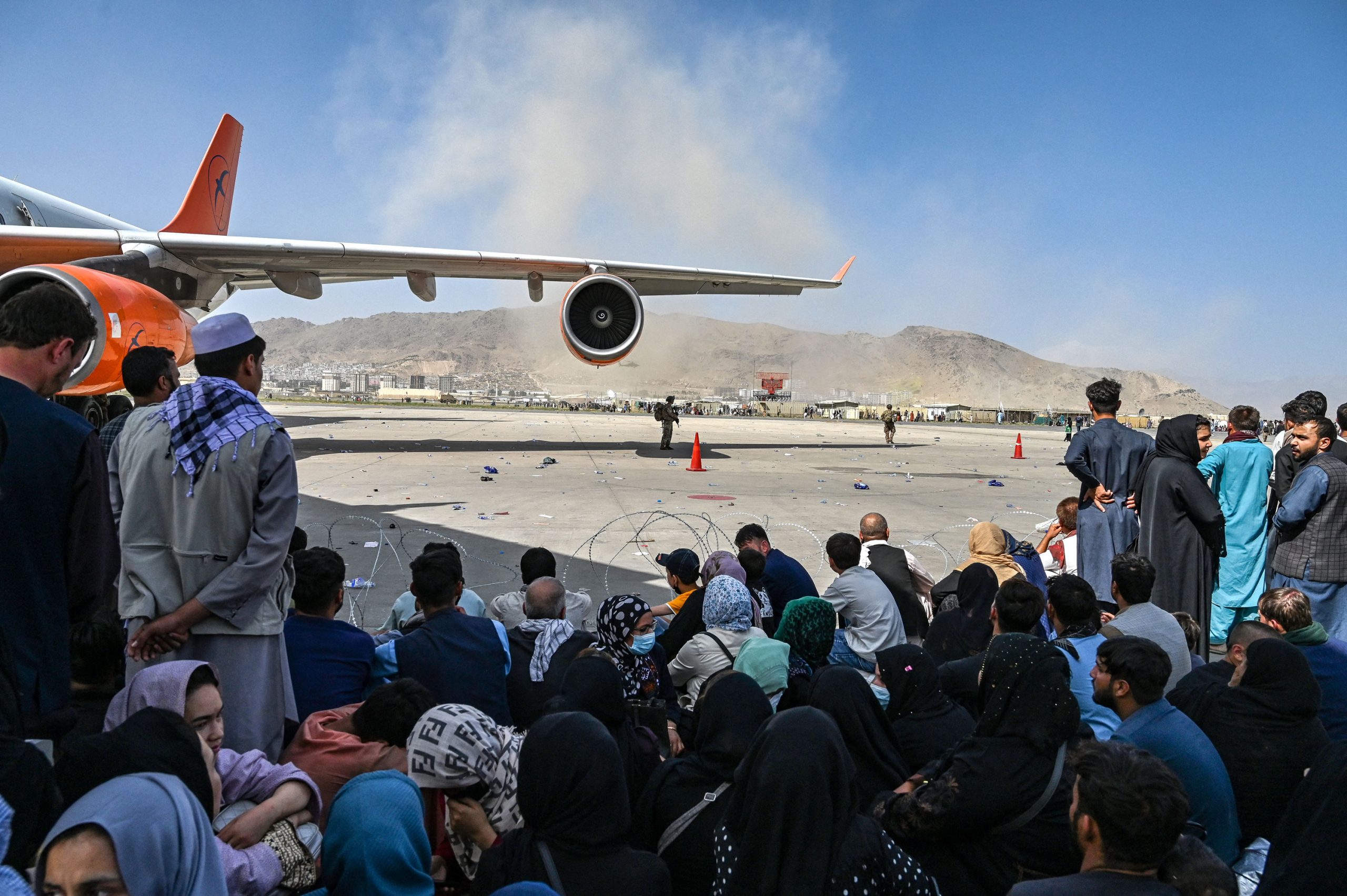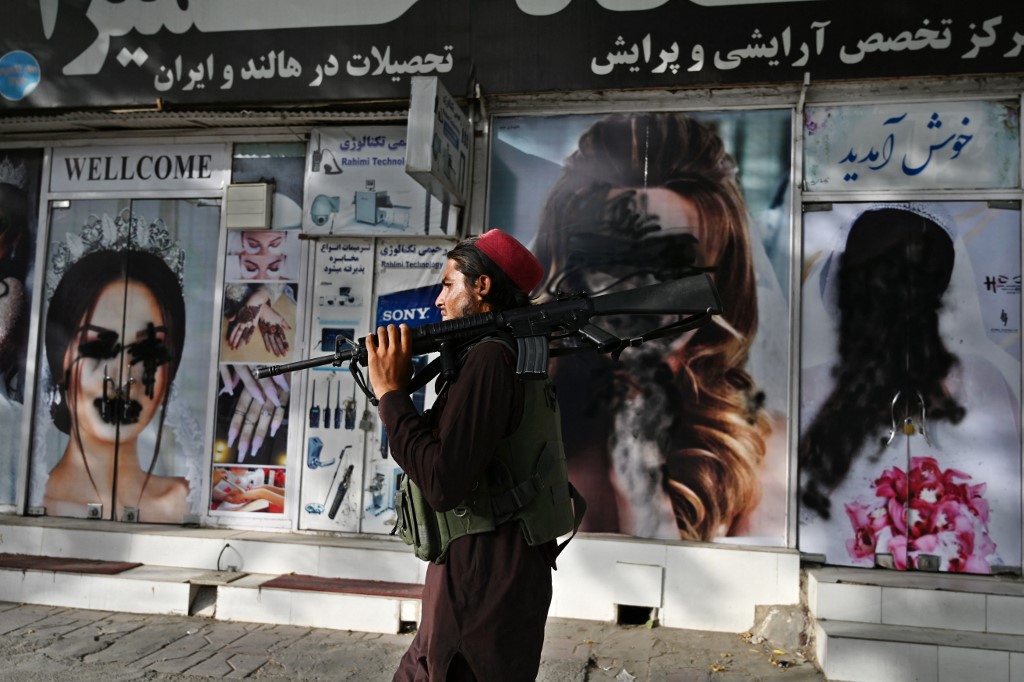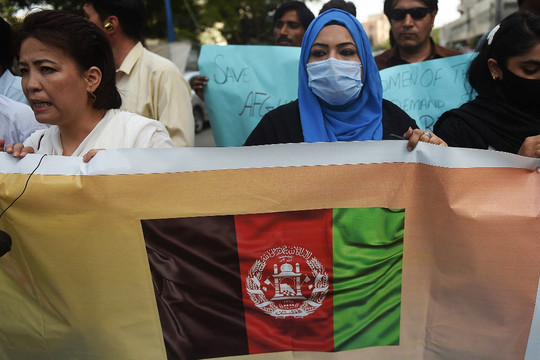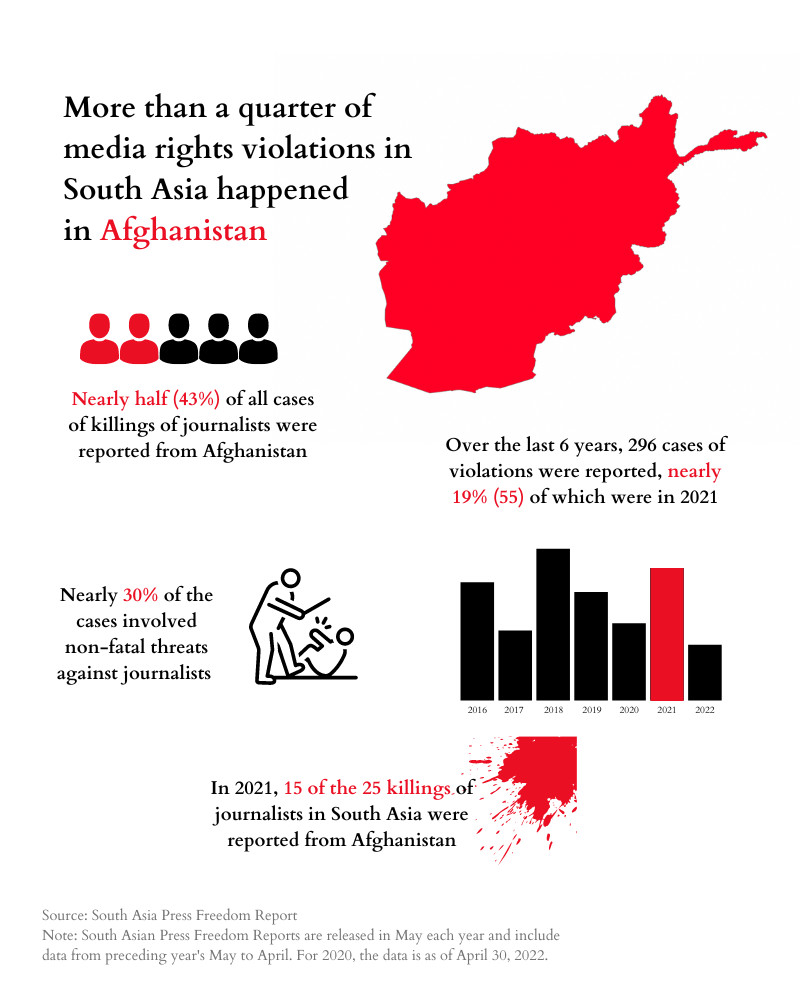AFGHANISTAN
Under the Taliban

A group sit and wait to leave Kabul on August 16, 2021, as thousands of people mobbed the city’s airport attempting to flee the Taliban’s impending regime. Credit: Wakil Kohsar / AFP
It has been a bleak year for the media in Afghanistan. Though the number of targeted killings and armed attacks on journalists dropped after the Taliban takeover of Kabul in August 2021, the past seven months has seen a serious spike in harassment, threats, beatings and detainments. Journalists not abiding by the media guidelines of the Taliban government are most at risk.
In this new media environment of restrictions, where self-censorship is one of the means to survival, Afghan journalists are courageously struggling to maintain standards of journalism. It has not been easy: access to information is limited, freedom of expression is curtailed, and the number of media houses operating has dropped to a quarter.
Many journalists are lying low, still hoping to flee the country through whatever means. Estimates suggest that anywhere between 600 to more than 1,000 journalists have fled the country, taking permanent or temporary refuge in the United States of America, Britain and other Asian and European countries. During the past 20 years, Afghanistan’s journalists and media workers sacrificed and endangered their lives and struggled for freedom of expression and high standards of journalism, only to see the results of their struggle at severe risk of disintegration.
Since August 2021, more than 300 media outlets have shut down. While some were closed due to threats from the Taliban, the majority, like other media outlets elsewhere in the region, have been unable to survive due to economic unviability, exacerbated by the downturn during the pandemic. Freezing of Afghanistan’s foreign reserves, and breakdown of the banking system has severely impaired the functioning of the economy, including that of the media industry. Those remaining are striving hard to uphold press freedom and professional journalism alongside struggling to pay tax arrears to renew their licenses.
Over the past 20 years, Afghanistan was ranked relatively high on the scale of access to information and freedom of expression. However, the current regime – despite promises that it would respect and honour a free press – has demonstrated little commitment to freedom of expression, causing a backslide of many years of progress. Even before the Taliban government, previous governments were also trying to censor the media in Afghanistan, but journalists were more united and the representatives of journalists’ associations put up an immediate and vigorous resistance.
Media organisations also played a significant advocacy role. As many as 18 journalists’ associations, gathered under the banner of the Afghanistan Journalists and Media Association, were instrumental in appointing a committee of member journalists and government representatives to hold monthly meetings to discuss journalists’ problems with senior government officials and work towards resolution. Overall, they had been instrumental in working for ethical media policies, and towards journalists’ rights and justice. Sadly, this body cannot operate in Afghanistan now.
In February 2022, the Afghanistan Journalists Federation wanted to hold a press conference to release a report about the situation of journalists in Afghanistan. However, the Taliban refused to let it take place on grounds that the Federation did not have a license. The National Directorate of Security of the Taliban surrounded the hall of the federation and stopped anyone from coming in or out. They also detained two representatives of the federation for hours. This clampdown on journalists’ right to association is another alarming characteristic of Taliban rule..
Critical juncture
“Unfortunately, there is no freedom of expression in Afghanistan right now and the media is completely censored,” said Mujeeb Khalwatgar, head of the Nai–Supporting Open Media in Afghanistan, who said that that there was now a Taliban representative in the corner of every newsroom, to control the news. He said journalists in Afghanistan are in a vulnerable situation as most of them have been rendered jobless and are in dire financial straits. Some are doing odd jobs simply to survive.
Ahmad Quraishi, head of the Afghanistan Journalists’ Center, said that 50 per cent of the media outlets in Afghanistan are shut down and another 30 per cent are only doing temporary broadcasts, which are also on the verge of closure.
One shift in the situation is that journalists are not getting killed or physically injured following the Taliban takeover. The exceptions are Ali Reza Ahmadi and Najma Sedeqi, who were killed on August 27, 2021, in in an explosion during the evacuation process at Kabul Airport. The ISIS claimed responsibility for the blast.
However, one of the most troubling issues now is that journalists under the Taliban suffer constant mental harassment and physical torture.
The set-back in achievements of the past 20 years in freedom of expression, access to information and gender equity is stark, even as a few media outlets struggle against all odds to keep independent media functioning. Afghanistan has lost hard-won assets: thousands of well-trained journalists, as most of them are fleeing the country or are currently jobless because of strict government control. The rest who are trying to work within the restrictions set by the Taliban are vulnerable to being mentally tortured, imprisoned and denied permission to independently report on important issues.
Afghanistan has never been a safe country for journalists, who have borne the brunt of targeted killings as well as being casualties on the frontlines of war and tribal conflicts. According to the IFJ’s monitoring published the annual South Asia Press Freedom Reports, more than 100 journalists and media workers have been killed in terrorist attacks, explosions and targeted killings since 2005. Those in the provinces have been particularly vulnerable.
Not only local media workers, but foreign journalists were beaten, imprisoned and their cameras and other equipment smashed and footage taken or discarded while they were doing their jobs. Nageib Khwaja, a Danish journalist, who went to Kabul on a reporting assignment in late August 2021, was beaten by the Taliban at the Kabul Airport and his phone taken. Nageib said: “When I went to Afghanistan after the fall of Kabul, I first got permission from the Taliban’s spokesman Zabiullah Mujahid. While I was interviewing people at Kabul Airport and recording the process of thousands of people sitting at the airport waiting for evacuation, the Taliban arrived and beat my colleague and I and then took away our phones and cameras. After many attempts we were able to get our equipment back.”
Jason Mutlagh, an American journalist who has travelled to Afghanistan three times since the fall of republic, says it is not easy for foreign journalists to cover Afghanistan now. “The last time I was in Afghanistan in February of 2022, there was a house-to-house search in Kabul. The foreign journalists’ houses in Kabul were searched and they were under severe mental pressure. We were negatively affected by the Taliban search and questions and could not easily conduct media activities as we were exhausted.”
Hujatullah Mujadidi, executive director of Afghanistan Independent Journalists Association (AIJA), expressed his concern about the ongoing harassment of journalists, though the killings of journalists had declined.
Media Rights Violations
Killings
Arrests
The current regime – despite promises that it would respect and honour a free press – has demonstrated little commitment to freedom of expression, causing a backslide of many years of progress.

A Taliban fighter walks past a beauty salon with images of women defaced using spray paint in Shar-e-Naw in Kabul on August 18, 2021. The Taliban immediately moved to enforce restrictions on women in the media, removing them from all broadcasts, introducing strict dress codes and limiting their mobility. Credit: Wakil Kohsar / AFP
The set-back in achievements of the past 20 years in freedom of expression, access to information and gender equity is stark, even as a few media outlets struggle against all odds to keep independent media functioning.
Independent media at risk
Denial of access to information, economic problems and lack of investigative journalism are the key and pressing issues for Afghan media and journalists. Mujadidi added: “Investigative journalism in Afghanistan doesn’t exist anymore because of the limitation of access to information. Currently, one or two media outlets are closing each month because of economic problems.” Only a few thousand journalists and media workers are left from the once strong industry that once employed at least 6,000 people. The rest have left the country or the profession.
Journalists and media workers are subjected to severe psychological pressure from the Taliban’s Ministry of the Propagation of Virtue and the Prevention of Vice, state agency in charge of implementing Islamic law in the Islamic Emirate of Afghanistan. According to the new norms, the content of entertainment and social programs on television should not be against the Sharia.
Media owners fear that if things do not change things in Afghanistan, their economic problems as well as external threats will eventually lead to the closure of almost all media outlets in the country. Danish Karokhel, the head of Pajhwok Afghan News agency, a privately owned media outlet, said the government of the Islamic Emirate regards the media as a negative phenomenon. Media have no access to information; they do not have any commercial advertisements to broadcast and funds from international organisations have dried up, he said. As a result, the few remaining journalists will also gradually lose their jobs.
“If the situation continues like this, the media will only publish official reports handed out by the current government instead of facts. It will lead to loss of the trust that media outlets have gained in the past 20 years. Consequently, there will be no freedom of expression and all the achievements will be neutralised.” According to Karokhel, in the last seven months, Pajhwok employees have been threatened at least 16 times and their journalists have been arrested, while ten journalists have resigned and left the country.
Journalists in the newsroom battle censorship on a daily basis, more so at the provincial level. even though reporters are largely considered enemies rather than as professionals carrying out a socially important role, many media outlets are steadfastly adhering to their professional duties, the most consistent being TOLOnews and TV One among a few others.
Journalists and media workers are subjected to severe psychological pressure from the Taliban’s Ministry of the Propagation of Virtue and the Prevention of Vice, state agency in charge of implementing Islamic law in the Islamic Emirate of Afghanistan.

A Taliban commander addresses members of the media after they halted a demonstration by women protestors in Kabul on September 30, 2021. Credit: Bulent Kilic / AFP
New curbs
In November 2021, the new Taliban government circulated a letter with 11 ‘rules’, urging the media to refrain from broadcasting TV programs and dramas which featured women.
Many provisions of this new regulation do not have clear definitions, and some are already mentioned in previous rules and regulation already set out for the media. Introduction of such regulations by the Taliban sends no additional message other than fear and censorship.
“It’s against the principles of journalism to set such limits on the media,” said Najeeba Ayoubi, the director of the Killid group media organisation. “These 11 rules are intended to scare and warn media managers and journalists that violate the Taliban rules, that they will be punished.”
Among its orders, the new regulation states:
- Issues which are against Islamic principles should not be published.
- National figures should not be depicted in satirical or comedy programs.
- Privacy of national figures should be maintained, and they should not be humiliated.
- Journalists should not publish anything that could have a negative or demoralising effect on people.
“With the publication of this regulation, the managers of local media who broadcast in provinces were terrified and some of them closed their media houses, while others completely changed the content and format of the broadcasts because of the harsh behaviour of local authorities,” said Ayoubi.
Overall, the previous industry estimated to be upwards of 6,000 of journalists and other media workers can be divided into three groups. Firstly, those in the country who are in difficult economic circumstances. Secondly, those who are still working in the media under high mental stress with no guarantee for their physical and mental health safety. Third, are those who have left the country or are waiting for their documents and visas in anticipation of leaving for a second or third country to settle. Those that have left remain in a very tough situation – because they know they cannot return to Afghanistan due economic and security problems and their life outside is neither pleasant nor easy.
Habibullah Khaibar, a journalist who has been waiting for five months in Macedonia for a visa to enter Canada, says: “I am suffering from severe mental stress, I am taking tablets for anxiety and depression every day, educated people [former government employees] are being killed and we are still in an uncertain situation. We have no idea about our future or where we will be taken, we are not provided with any kind of information”.
Women journalists’ struggle
Women journalists are placed in a particularly vulnerable situation. Most women journalists, especially in the initial uncertain days of the takeover, feared going outside their homes. The fears are not unfounded, as they had witnessed the killing of female colleagues in Enikaas TV in Nangarhar as recently as December 2020 and March 2021. Lack of security and the killings of women human rights defenders by unidentified persons heightened the risks for women journalists.
A reporter in the southern province of Helmand, who did not want to be named, said: “I received a letter from the department of information and culture and national directorate of security, which states no one media can publish reports containing the shortcomings of the government without Taliban permission and approval. It also states: “Women should be completely expelled from the media, if anyone violates this order, they will be severely punished.”
For women in Afghanistan’s media, the beginning of Taliban rule was also filled with dread as Taliban militants terrifyingly entered TV station offices to announce their victory. In August 2021, a commander of Taliban appeared in an interview with two armed guards behind him. This broadcast, from a studio where news was normally presented, not only affected the journalists but negatively affected public perceptions of the media.
The Taliban have continued to send commanders and media representatives to television programs to persuade them to talk in their favour. Political analysts and commentators continue to be wary of going on programs as expressing opinions freely might have repercussions. In the past seven months, three university lecturers, tens of women and men activists have been imprisoned and many of them are still incarcerated. In a setback for women, the Taliban ordered that woman were no longer allowed to drive alone, unaccompanied by a male family member. Benazir Baktash, an employee of a private television, said: “I was stopped. I was told to not drive without a male companion. So now I am using public transport.”
While women journalists in provinces are finding it increasingly difficult to work, those that continue to work in Kabul must follow a strict dress code and restrictions on their mobility. Yet, women journalists have not ceded their rightful place in the media.
Currently, the Moby Media Group, which includes TOLOnews, Tolo TV, Lemar TV, Radio Arakozia and Radio Arman employs more than 80 women. Among the seven news anchors in Tolo News, three are women. Radio Harirzan in Badakhshan province has also resumed broadcasting and Radio Begum for Women has broadcasts in Kabul. Zan TV also opened its office with the presence of women and started broadcasting on social networks and is scheduled to resume broadcasting.
At provincial levels, media owners are in a bind. They do not have commercial advertisements as before and support from international foundations has all but vanished.
Sediqullah Afghan, the head of a private radio in Kandahar, said as well as economic problems, Kandahar provincial officials created other problems which directly affected their broadcasting. In November 2021, media’s leaders were invited by the Taliban in Kandahar and were instructed to avoid broadcasting music, programs in which girls participate and programs which are against our society norms and culture. The Taliban recently suspended their radio license for a while and they were forced to stop government advertisements.
In February 2022, Taliban spokesman Zabiullah Mujahid told reporters at a press conference that they were aware of current problems of journalists and were working to facilitate access to information and refrain restrain officials from intervening in the media’s operations. How this plays out remains to be seen.
Some steps towards making a dent in the country’s impunity may be reason for cautious optimism. A petition was filed on March 22, 2022, in the International Criminal Court against six Taliban leaders by the parents of Danish Siddiqui, a Pulitzer prize-winning Reuters journalist from India. Siddiqui was killed (and allegedly tortured) in a Taliban ambush in Spin Boldak, Kandahar, on July 16, 2021. Whatever the outcome of the petition, it represents a significant step towards pressing for accountability from the Taliban government.
For women in Afghanistan’s media, the beginning of Taliban rule was also filled with dread as Taliban militants terrifyingly entered TV station offices to announce their victory.

Demonstrators stand in solidarity with Afghanistan during a protest organised by the Afghan Solidarity Committee in Karachi on August 24, 2021. Credit: Rizwan Tabassum / AFP
Wither the Afghan media
Besides the massive political upheaval, Afghanistan continues to reel under economic hardships after the international community cut off non-humanitarian funding which previously accounted for almost 40 per cent of the country’s GDP.
The spin off from the economic crisis is the emerging humanitarian emergency that has, according to the International Red Cross, left a quarter of the population facing risk of famine, hunger and malnutrition. The UN Development Program estimates that 97 per cent of Afghanistan’s population will “plunge” into poverty while the UNICEF estimates that up to a million children under five years of age could die by the end of 2022 due to Afghanistan’s food crisis and the lack of water and sanitation.
An independent media is essential to tell the world the complex unfolding story of Afghanistan.
Journalists remaining in Afghanistan, as well as those who have left, desperately need support from the international community. There is need for solidarity and interventions on several fronts. The Afghan journalists who have fled the country need support to relocate and restart their lives. Release from military camps in Pakistan, Abu Dhabi, Macedonia and Albania and facilitation of visas to proceed to their destination must be a priority. Support in terms of finances, skills building, resources and jobs to integrate them into their new homes is also the need of the hour.
Within Afghanistan, a functioning economy needs to be restored after freezing of its assets, international sanctions and cuts in aid have contributed to a severe financial crisis in the country. Besides immediate financial assistance to survive in the short term, journalists and media houses need funds, training for the newly hired media workers and support from the international community to help rebuild the media. Regaining lost ground is crucial. Support for women journalists who are currently out of jobs, is a need that the international community can and must fulfil.
Journalists remaining in Afghanistan, as well as those who have left, desperately need support from the international community. There is need for solidarity and interventions on several fronts.

